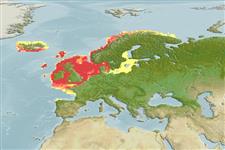Preferred temperature (Ref.
123201): 6.9 - 11.8, mean 8.9 °C (based on 284 cells).
Phylogenetic diversity index (Ref.
82804): PD
50 = 0.6250 [Uniqueness, from 0.5 = low to 2.0 = high].
Bayesian length-weight: a=0.00776 (0.00687 - 0.00878), b=3.09 (3.05 - 3.13), in cm total length, based on LWR estimates for this species (Ref.
93245).
Trophic level (Ref.
69278): 3.0 ±0.0 se; based on diet studies.
Generation time: 3.9 (3.0 - 4.4) years. Estimated as median ln(3)/K based on 20
growth studies.
Widerstandsfähigkeit (Ref.
120179): niedrig, Verdopplung der Population dauert 4,5 - 14 Jahre. (K=0.3-0.6; tm=2-3; tmax=12; Fec=50,000).
Prior r = 0.68, 95% CL = 0.45 - 1.02, Based on 3 full stock assessments.
Fishing Vulnerability (Ref.
59153): Moderate vulnerability (40 of 100).
🛈
Climate Vulnerability (Ref.
125649): Moderate vulnerability (43 of 100).
🛈
Nutrients (Ref.
124155): Calcium = 17.8 [7.9, 75.9] mg/100g; Iron = 0.294 [0.148, 0.565] mg/100g; Protein = 15.7 [13.4, 18.4] %; Omega3 = 0.319 [0.152, 0.656] g/100g; Selenium = 9.9 [3.4, 35.3] μg/100g; VitaminA = 7.93 [1.59, 40.88] μg/100g; Zinc = 0.339 [0.178, 0.808] mg/100g (wet weight);
